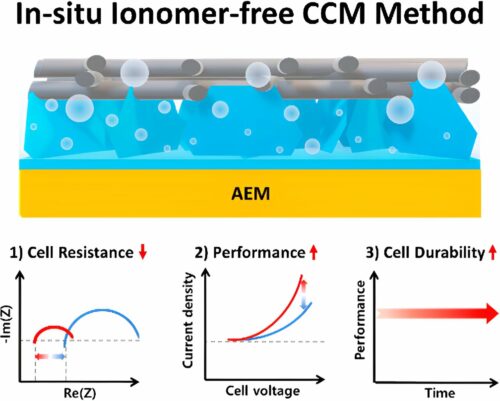The latest electrolyzer technology boosts hydrogen production efficiency, marking a significant step towards sustainable and effective green hydrogen energy solutions.

In the quest for sustainable energy solutions, more efficient hydrogen production methods are paramount. Advancements in electrolyzer technology are crucial for harnessing green hydrogen energy effectively and sustainably.
Researchers from the School of Chemical Engineering at UNIST have developed a technology to enhance the performance of electrolyzers in hydrogen production. This innovation is a notable stride towards commercialising green hydrogen production technology.
The team has devised a new in-situ, ionomer-free method for creating catalyst-coated membranes (m-CCM). This technique allows for the direct synthesis and integration of a catalyst layer between the anion exchange membrane (AEM) and the gas diffusion layer, eliminating the need for anion exchange ionomers. This method overcomes the constraints of traditional membrane electrode assembly (MEA) fabrication processes.
The Anion Exchange Membrane Water Electrolyzer (AEMWE), created using the m-CCM method and featuring a platinum group metal-free anode catalyst, has shown superior performance to traditional MEA-based electrolyzers.
This m-CCM approach enhances interfacial resistance, optimises catalyst usage, and ensures close contact. It achieves an industrial-grade current density of 1 A cm-2 at a cell voltage of 1.79 Vcell. The method is also exceptionally durable, sustaining over 200 hours of continuous electrolysis at 50°C in 1 M KOH electrolyte.
In addition, the AEMWE reaches a current density of 500 mA cm-2 at 1.913 Vcell, displaying a low degradation rate of 0.58 mV h-1 over 260 hours of continuous operation at a current density of 250 mA cm-2. This performance is maintained while operating at 50°C using ultrapure water.
This technology’s enhanced performance and stability stem from the direct cultivation of the catalyst layer, which removes the necessity for ionomers typically employed in membrane electrode assembly production. The m-CCM method’s exclusion of ionomers and its direct catalyst layer growth optimise the interface between the membrane, catalyst, and support, improving performance and stability.
Reference: Tae-Hoon Kong et al, In-Situ Ionomer-Free Catalyst-Coated Membranes for Anion Exchange Membrane Water Electrolyzers, ACS Energy Letters (2023). DOI: 10.1021/acsenergylett.3c01418





